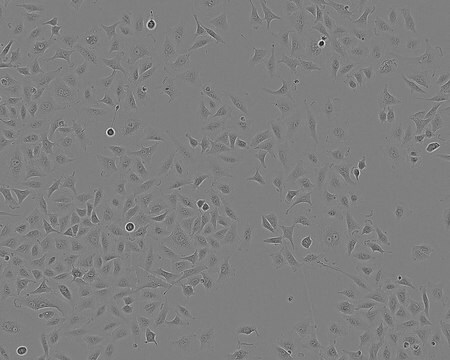About This Item
Kod UNSPSC:
41106514
Polecane produkty
product name
DMS 79, 95062824
pochodzenie biologiczne
human lung
tryb wzrostu
Aggregates in suspension
kariotyp
Aneuploid
morfologia
Irregular
produkty
Not specified
receptory
Not specified
metody
cell culture | mammalian: suitable
powiązane choroby
cancer
Warunki transportu
dry ice
temp. przechowywania
−196°C
Pochodzenie linii komórkowej
Human lung small cell carcinoma
Opis linii komórkowej
DMS79 has been established from pleural fluid of a patient with small cell carcinoma of the lung. The patient was treated with cytoxan, vincristine, methotrexate and radiation therapy. The cultures show a tendency for the modal chromosome number to decline. The production of adrenocorticotropin (ACTH), bombesin, calcitonin, β-endorphin, 17-β-estradiol, lipotropin, ocytocin-neurophysin, parathyroid hormone and somatstatin-like imuno-reactivity has been reported. The cells have also been reported to have the following cell surface antigens: Leu-7, Class I HLA, Class II HLA, Mg23 defined by the AML-2-23 monoclonal antibody and the AML-1-99 defined antigen. The cells have a receptor for epidermal growth factor (EGF) and produce tumours in nude athymic mice. Cells grow as irregularly shaped aggregates.
Zastosowanie
Human lung tumour model, carcinogenesis studies.
pożywka hodowlana
RPMI 1640 + 2mM Glutamine + 10% Foetal Bovine Serum (FBS) (Heat Inactivated).
Rutyna subkultury
Maintain cultures between 3 ? 9 x 100,000 cells/ml; 5% CO2; 37°C. Only dilute 1:2 as a maximum. This cell line grows as clumps in suspension which can be easily dispersed with pipetting. Trypsinisation is not necessary. Routine splitting can therefore
Inne uwagi
Additional freight & handling charges may be applicable for Asia-Pacific shipments. Please check with your local Customer Service representative for more information.
This page may contain text that has been machine translated.
Certyfikaty analizy (CoA)
Poszukaj Certyfikaty analizy (CoA), wpisując numer partii/serii produktów. Numery serii i partii można znaleźć na etykiecie produktu po słowach „seria” lub „partia”.
Masz już ten produkt?
Dokumenty związane z niedawno zakupionymi produktami zostały zamieszczone w Bibliotece dokumentów.
Nasz zespół naukowców ma doświadczenie we wszystkich obszarach badań, w tym w naukach przyrodniczych, materiałoznawstwie, syntezie chemicznej, chromatografii, analityce i wielu innych dziedzinach.
Skontaktuj się z zespołem ds. pomocy technicznej


